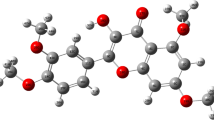Abstract
Four novel ligands, namely N-benzhydryl benzamide, N, N-diphenethyl benzamide, N, N-dihexyl benzamide, and N, N-dioctyl benzamide (L1, L2, L3, and L4, respectively), based on the benzamide unit were designed and computed for their different properties, such as absorption spectrum, dipole moment, theoretically expected biological properties, and frontier molecular orbitals, by evaluating the HOMO/LUMO energy orbitals strength with DFT approaches and comparing these properties with the R benzamide properties available in literature. All molecules have a suitable frontier molecular orbital diagram and L1 exhibits maximum absorption at 246.8 nm due to the strong electron donating effect of the diphenylmethane ligand group. Moreover, strongly extended conjugated groups caused a redshift in absorption spectra. Newly designed molecules may show strong biological activities against cancer, bacterial diseases, and harmful fungal disorders.

Orbital energy, electron density and frontier molecular orbitals view of four designed novel benzamide derivates








Similar content being viewed by others
References
Fujita K-i et al (2003) N-alkylation of amines with alcohols catalyzed by a Cp* Ir complex. Tetrahedron Lett 44(13):2687–2690
Guillena G, Ramón DJ, Yus M (2009) Hydrogen autotransfer in the N-alkylation of amines and related compounds using alcohols and amines as electrophiles. Chem Rev 110(3):1611–1641
Wetzel S et al (2011) Biology-oriented synthesis. Angew Chem Int Ed 50(46):10800–10826
Zhu Z, Chen D (2002) Nitrogen fertilizer use in China–contributions to food production, impacts on the environment and best management strategies. Nutr Cycl Agroecosyst 63(2–3):117–127
Weil RR, Brady NC, Weil RR (2016) The nature and properties of soils. Pearson, London
Lv W et al (2017) Synthesis of 2-Alkylaminoquinolines and 1, 8-Naphthyridines by successive ruthenium-catalyzed Dehydrogenative annulation and N-alkylation processes. Adv Synth Catal 359(7):1202–1207
Bundrick W et al (2003) Levofloxacin versus ciprofloxacin in the treatment of chronic bacterial prostatitis: a randomized double-blind multicenter study. Urology 62(3):537–541
Perkins JC, Devetski M, Dowling M Ampicillin in the treatment
Yunus M, Rahman ASM, Faruque ASG, Glass RI (1981) A clinical trial of ampiciline versus trimethoprimsulfamethoxazole in the treatment of shigella dysentery. Dacca, ICDDRB; 1981
Pearson DC et al (1995) Azathioprine and 6-mercaptopurine in Crohn disease: a meta-analysis. Ann Intern Med 123(2):132–142
Pearson D et al. (2000) Azathioprine for maintaining remission of Crohn's disease. Cochrane Database Syst Rev (2):CD000067–CD000067
Burghart A et al (1999) 3, 5-Diaryl-4, 4-difluoro-4-bora-3a, 4a-diaza-s-indacene (BODIPY) dyes: synthesis, spectroscopic, electrochemical, and structural properties. J Org Chem 64(21):7813–7819
Friedli F (2001) Detergency of specialty surfactants 98.
Holmberg K (2003) Novel surfactants: preparation applications and biodegradability, revised and expanded 114. CRC, Boca Raton
Egan R (1978) Cationic surface active agents as fabric softeners. J Am Oil Chem Soc 55(1):118–121
Yanai T, Tew DP, Handy NC (2004) A new hybrid exchange–correlation functional using the coulomb-attenuating method (CAM-B3LYP). Chem Phys Lett 393(1–3):51–57
Mohan N et al (2010) Comparison of aromatic NH··· π, OH··· π, and CH··· π interactions of alanine using MP2, CCSD, and DFT methods. J Comput Chem 31(16):2874–2882
Chattaraj PK, Bhaumik S, Niser B Check of size consistency in different levels of theory
Frisch MJ, Trucks GW, Schlegel HB, Scuseria GE, Robb M, Cheeseman JR et al (2009) Gaussian 09, revision D. 01. Gaussian, Inc., Wallingford, CT
Dennington RD, Keith TA, Millam JM (2008) GaussView 5.0. 8. Gaussian Inc, Wallingford
Civalleri B et al (2008) B3LYP augmented with an empirical dispersion term (B3LYP-D*) as applied to molecular crystals. Cryst Eng Comm 10(4):405–410
Adamo C, Barone V (1998) Exchange functionals with improved long-range behavior and adiabatic connection methods without adjustable parameters: the m PW and m PW1PW models. J Chem Phys 108(2):664–675
Chai J-D, Head-Gordon M (2008) Long-range corrected hybrid density functionals with damped atom–atom dispersion corrections. Phys Chem Chem Phys 10(44):6615–6620
Yu C, Hao X, Shen Q (2010) Illustration of origin 8.0. Chemical Industry Press, Beijing
Tenderholt AL (2006) PyMOlyze: a program to analyze quantum chemistry calculations, version 2.0.
Mariappan A, Das KM, Jeganmohan M (2018) Remote alkylation of N-(quinolin-8-yl) benzamides with alkyl bromides via ruthenium (ii)-catalyzed C–H bond activation. Org Biomolec Chem 16(18):3419–3427
Srivastava SK, Chauhan PMS, Bhaduri AP (1999) A novel strategy for N-alkylation of primary amines. Synth Commun 29(12):2085–2091
Daniel P et al. (2018) Palladium-catalyzed synthesis of α-trifluoromethyl benzylic amines via fluoroarylation of gem-difluoro-2-azadienes enabled by phosphine-catalyzed formation of an azaallyl–silver intermediate. ACS Catal 9(1):205–210
Wolf M et al (2005) Alkylating benzamides with melanoma cytotoxicity: role of melanin, tyrosinase, intracellular pH and DNA interaction. Melanoma Res 15(5):383–391
Han C et al (2004) Copper-mediated synthesis of N-acyl vinylogous carbamic acids and derivatives: synthesis of the antibiotic CJ-15,801. Org Lett 6(1):27–30
Shalaby AA et al (2000) Synthesis and antifungal activity of some new quinazoline and benzoxazinone derivatives. Archiv der Pharmazie: Int J Pharmaceut Med Chem 333(11):365–372
Muktapuram PR et al (2012) Anticancer siRNA delivery by new anticancer molecule: a novel combination strategy for cancer cell killing. Eur J Med Chem 56:400–408
Abdizadeh T et al (2017) Design, synthesis and biological evaluation of novel coumarin-based benzamides as potent histone deacetylase inhibitors and anticancer agents. Eur J Med Chem 132:42–62
Prajapati AK, Modi VP (2011) Synthesis and biological activity of n-{5-(4-methylphenyl) diazenyl-4-phenyl-1, 3-thiazol-2-yl} benzamide derivatives. Química Nova 34(5):771–774
Acknowledgments
The Computations/simulations/SIMILAR were performed on resources provided by the Swedish National Infrastructure for Computing (SNIC) at Umeå University, 901 87, Umeå, Sweden. The authors acknowledge the financial and technical support from Punjab Bio-energy Institute (PBI), University of Agriculture Faisalabad (UAF). Dr. MAI is thankful to HEC-Pakistan for awarding research Project NRPU-8396.
Author information
Authors and Affiliations
Corresponding authors
Ethics declarations
Conflict of interest
The authors declare no conflict of interest.
Additional information
Publisher’s note
Springer Nature remains neutral with regard to jurisdictional claims in published maps and institutional affiliations.
Electronic supplementary material
ESM 1
(DOCX 28 kb)
Rights and permissions
About this article
Cite this article
Amanullah, Ali, U., Ans, M. et al. Benchmark study of benzamide derivatives and four novel theoretically designed (L1, L2, L3, and L4) ligands and evaluation of their biological properties by DFT approaches. J Mol Model 25, 223 (2019). https://doi.org/10.1007/s00894-019-4115-3
Received:
Accepted:
Published:
DOI: https://doi.org/10.1007/s00894-019-4115-3




